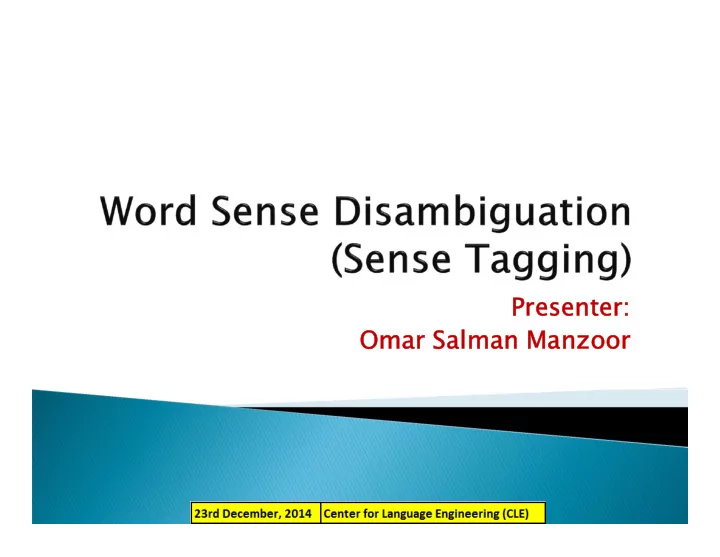

Presenter: Omar Salman Manzoor
Word Sense Disambiguation refers to the task of identifying the correct meaning and sense of a word according to the context. It is quite useful and vital in many natural language processing applications like machine translation. Statistic data extracted from sense tagged corpus can be implemented in ◦ Information Retrieval (IR) ◦ Information Extraction ◦ Text Summarization
An Urdu Sense Tagged Corpus has been developed. The need for developing WSD is to use this corpus to develop a training model which can assign senses to various words. WSD for Urdu is important because it can be used to enhance the Urdu Word Net by adding more senses and also adding relationship between various senses
He deposited money in the bank. He likes to go visit the river bank every Sunday. The task here is to provide the correct meaning of the word bank in each case.
Supervised Learning methods Dictionary Methods Bootstrapping Approach Unsupervised Learning
Collocation Features Collocation is a word or phrase in a position specific relationship to a target word. These features encode information about specific words or phrases located at specific positions to the left or right of the target word.
Bag of Words Features These features include an unordered set of words. A specific window size is chosen with the target word at the center so that words to the right and left of the target word are checked.
Naïve Bayes Classifier P(f|s) ≈ j=1 ∏ n P ( f j |s) Probability of feature vector given a sense estimated by the probabilities of its individual features given that sense. Training the classifier first requires estimate for prior probability of each sense. Also needed are individual feature probabilities given a sense. Smoothing is essential in this approach.
Decision List Classifiers.. A sequence of tests applied to each target word feature vector. A test indicates a particular sense. If a test succeeds that sense is applied. Otherwise next test is applied and process continues. In case of no test succeeding majority test retuned as default.
Lesk Algorithm Chooses the sense whose dictionary gloss or meaning shares the most words with the target word’s neighborhood. Example : The bank can guarantee deposits will cover future tuition costs because it invests in adjustable-rate mortgage securities.
Semi or Minimally Supervised Learning. Need only a small set of hand labeled data. Small seed set of labeled instances Λ 0 of each sense. A larger unlabeled corpus V 0. Algorithm first trains initial classifier on Λ 0 and then labels the corpus V 0 . Then examples in V 0 that are most convincing are added to training set now becomes Λ 1 . This is repeated.
Clustering Similar senses occur in similar contexts and are found by clustering based on similarity in context referred to as word sense induction. New instances classified into closet induced clusters.
Total Number of Sentences is 5611 Total Number of Words is 100,000 Tagged total word types 2225 Tagged total sense types 2285 Tagged total word tokens 17006 559 words which have more than 2 senses tagged. 1522 words with one sense.
Challenges include ambiguity in tagging non standardized translations of some English Words. For some foreign language words no sense tagging found. E.g. test match, basket ball There are complex predicates in Urdu. Normalization is required. This corpus can act as a seed corpus.
There are a number of pre processing considerations like stemming and removal of stop words. The data has a number of senses which have not been tagged sufficiently. Many of the words in the data have not been tagged or have no specific sense tags.
We plan on using the words which have at least 20 tagged instances . Using these instances the idea is to develop a semi supervised learning algorithm using Naïve Bayes Classification as the base method. Then labeling of the untagged data will be done automatically by choosing only the most confident output instances through clustering.
Recommend
More recommend